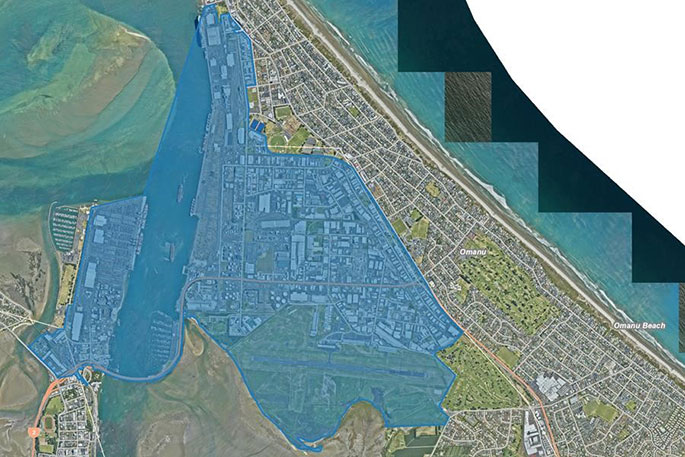A new, official airshed covering the Mount Maunganui industrial area will help Bay of Plenty Regional Council better manage air quality in the area – enabling tighter rules and consent decisions and a greater ability to manage industrial discharges.
Associate Minister for the Environment, Hon. Nanaia Mahuta approved the airshed, which becomes effective from today, after Regional Council requested more management tools from Central Government to address increasing concerns around dust and poor air quality in the area.
Bay of Plenty Regional Deputy Chair, Jane Nees, says looking after the region's air quality is part of the council's role as guardians of the local environment.
'The community have been concerned about the quality of air in the Mount Maunganui industrial area for some time and as a result, the Council put a network of monitors in place across the area to better understand the problem.
'At $500,000 a year this has been a significant investment, but in the last 12 months since monitoring began, we have detected a number of exceedances of the PM10 limits which is simply not acceptable."
Under the new Mount Maunganui Airshed, new consent applications for activities that discharge a fine inhalable dust, called particulate matter (or PM10), as part of their processes, cannot be granted consent if they are likely to increase offsite PM10 concentrations. This is unless the pollutants can be offset in some way in another part of the airshed.
The fine dust can cause breathing and health problems, particularly for the elderly and children, and for those suffering from asthma.

'The new Airshed means we can specifically target industrial discharges in this area and introduce tighter restrictions if required,” says Jane.
'While this won't address the odour issues we get hundreds of calls about each year, for the communities living next door, as well as those who work on site or travel through the area, this is a great step in the right direction."
The Regional Council has proactively been working with industry, log handlers, dry bulk material (such as palm kernel) distributors and the Port of Tauranga to address the dust problem and is seeing some real improvement.
'We're seeing more sweeper trucks, water carts and sealed storage facilities being used, but to improve air quality in this area some businesses are going to have to change the way they do things. Aging infrastructure and equipment needs to be upgraded and more dusty surfaces sealed. This will simply be part of doing business in this area in the future.
'Our role as a regional council is to look after and monitor our environment, so that it can be enjoyed by everyone, for generations to come. Ensuring clean air is an important part of this role.
'We also want to acknowledge the huge amount of work done by the communities who are especially affected by air pollution in this area, such as those living in the Whareroa area, to demand better."
For more information on Mount Maunganui industrial air quality visit the Regional Council's website at www.boprc.govt.nz/mountindustrial .
Background
- An airshed is a legally designated air quality management area.
- New Zealand's air space is divided into what is now 74 ‘airsheds'. Prior to being carved off as a separate airshed, the Mount industrial area formed part of the wider Bay of Plenty airshed.
- You can view air quality data for the Mount industrial area here.
- The National Environmental Standards for Air Quality are regulations which aim to set a guaranteed minimum level of health protection for all New Zealanders. The safe 24 hour average limit of the National Environmental Standards for Air Quality for PM10 is 50 µg/m3. One exceedance of this limit is permitted over a 12 month period.
- You can view a summary the limits, and the exceedances we've recorded for this area here.
- Regional Councils must monitor air quality and inform the public if the Standards are breached. Under the new Mount Manganui Airshed Bay of Plenty Regional Council must decline resource consent applications if it is likely that the consented activity would increase concentrations of certain contaminants in polluted airsheds, or cause certain contaminant levels to breach ambient air quality standards.
- The Mount Maunganui industrial area comprises of 270 hectares of industrially zoned land, and 186 hectares of Port of Tauranga (PoT) owned land, and is home to a number of activities and industries that discharge to air, land and water.
- Between June 2017 and January 2019 we received more than 900 complaints about air pollution issues from this area, the majority relating to odour and smoke.
- If any individuals have personal health concerns they should contact their GP.



3 comments
Good
Posted on 28-11-2019 15:23 | By Tardis
It's at least a start. It's a shame regional and local council often seem to behind the 8 ball as they say.
Yet my neighbour...
Posted on 28-11-2019 15:25 | By jed
Yet my neighbour just outside the blue zone, can light smoky fires in his backyard that fill my house with smoke and particulates. The council (and regional council) need to ramp up noise and pollution control.
Staggering
Posted on 28-11-2019 15:50 | By peecee09
I am staggered that the survey area contains virtually no residential areas. The residential areas are mainly on the Eastern side of Maunganui Road and are not included. How ridiculous.
Leave a Comment
You must be logged in to make a comment.